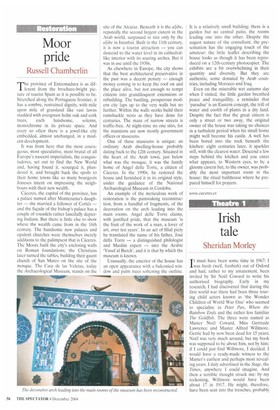Moor Pride
Russell Chamberlin
Theprovince of Extremadura is as different from the brochure-bright picture of tourist Spain as it is possible to be. Stretched along the Portuguese frontier, it has a sombre, restrained dignity, with mile upon mile of grassland like vast lawns studded with evergreen holm oak and cork
trees, each handsome, solemn, monochrome in its private space. And every so often there is a jewel-like city embedded, almost unchanged, in a modern development.
It was from here that the most courageous, most speculative, most brutal of all Europe's nascent imperialists, the conquistadores, set out to find the New World and, having found it, scourged it, plundered it, and brought back the spoils to their home towns like so many bourgeois Joneses intent on impressing the neighbours with their new wealth.
Caceres, the capital of the province, has a palace named after Montezuma's daughter — she married a follower of Cortes — and the façade of the bishop's palace has a couple of roundels rather fancifully depicting Indians. But there is little else to show where the wealth came from in the 16th century. The handsome new palaces and opulent churches were themselves merely additions to the palimpsest that is Caceres. The Moors built the city's enclosing walls on Roman foundations; the Christians later turned the tables, building their gaunt church of San Mateo on the site of the mosque. The Casa de las Veletas, today the Archaeological Museum, stands on the site of the Alcazar, Beneath it is the aljibe, reputedly the second largest cistern in the Arab world, surpassed in size only by the aljibe in Istanbul. Built in the 11th century, it is now a tourist attraction — you can descend to the water level in its cathedrallike interior with its soaring arches. But it was in use until the 1930s.
As elsewhere in Europe, the city shows that the best architectural preservative in the past was a decent penury — enough money coming in to keep the roof on and the place alive, but not enough to tempt citizens into grandiloquent extensions or rebuilding. The bustling, prosperous modern city laps up to the very walls but no further. Within the walls storks build their ramshackle nests as they have done for centuries. The maze of narrow streets is traffic-free. At night-time no one stirs, for the mansions are now mostly government offices or museums.
One of these museums is unique; an ordinary Arab dwelling-house probably dating back to the 12th century. Situated in the heart of the Arab town, just below what was the mosque, it was the family home of Angel delle Torre, a citizen of Caceres. In the 1990s, he restored the house and furnished it in its original style, under the guidance of the National Archaeological Museum in Cordoba.
An example of the meticulous work of restoration is the painstaking reconstruction, from a handful of fragments, of the decoration on the arch leading into the main rooms. Angel delle Torre claims, with justified pride, that the museum 'is the fruit of the work of a man, a lover of art, over ten years'. In an act of filial piety he translated the name of his father, Jose della Torre — a distinguished philologist and Muslim expert — into the Arabic ltiusuf al Burch', and it is that by which the museum is known.
Unusually, the exterior of the house has an open appearance with a balconied window and palm trees softening the outline. It is a relatively small building; there is a garden but no central patio, the rooms leading one into the other. Despite the august nature of the consultant, the presentation has the engaging touch of the amateur: the little leaflet describing the house looks as though it has been reproduced on a 12th-century photocopier. The exhibits are a bit overwhelming in their quantity and diversity. But they are authentic, some donated by Arab countries, including Morocco and Iraq.
Even on the miserable wet autumn day when I visited, the little garden breathed peace and tranquillity, a reminder that 'paradise' is an Eastern concept, the trill of water and coolth of plants in a dry land. Despite the fact that the great cistern is only a street or two away, the original owner of the house was taking no chances in a turbulent period when his small home might well become his castle. A well has been bored into the rock beneath the kitchen: eight centuries later, it sparkles still, with the clearest water. Descend a few steps behind the kitchen and you enter what appears, to Western eyes, to he a gloomy cavern but, to the owner, was probably the most important room in the house: the ritual bathhouse where he prepared himself for prayers.
www.eaceres.es


















































































 Previous page
Previous page